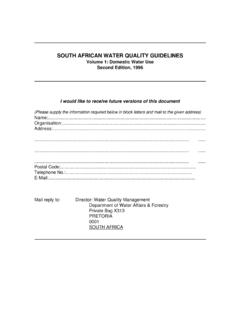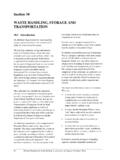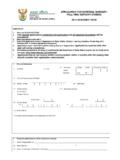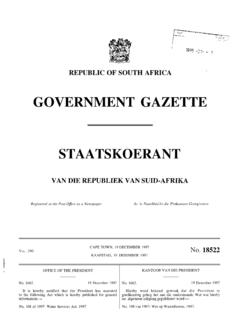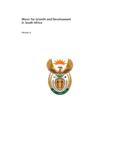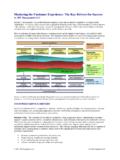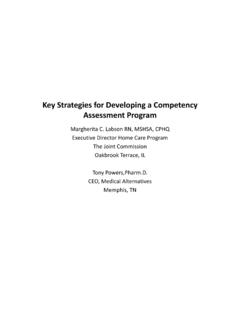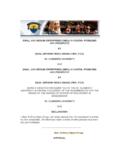Transcription of List of Acrynoms - DWAF
1 List of Acrynoms BD Blue Drop BDS Blue Drop System ( ). DBSA Development Bank of Southern Africa DM District Municipality DWA Department of Water Affairs DWQ Drinking Water Quality DWQM Drinking Water Quality Management eWQMS Electronic Water Quality Management System LM Local Municipality O&M Operation and Maintenance RWS Rural Water Scheme UK United Kingdom WSA Water Service Authority WSP Water Service Provider WTW Water Treatment Works Blue Drop Report Contents Page National Overview 1. Blue Drop Report Card Scoring Criteria 2010 8. Chapter 1 - EASTERN CAPE 12. Chapter 2 - FREE STATE 46. Chapter 3 - GAUTENG 68. Chapter 4 - Kwa-Zulu NATAL 84. Chapter 5 - LIMPOPO 122. Chapter 6 - MPUMALANGA 146. Chapter 7 - NORTH WEST 170.
2 Chapter 8 - NORTHERN CAPE 186. Chapter 9 - WESTERN CAPE 230. National Overview Introduction The Department of Water Affairs initiated the drinking water quality (DWQ) regulation programme in 2005 with the objective of ensuring the improvement of tap water quality by means of compliance monitoring. A survey conducted in the preceding year indicated that less than 50% of municipalities then monitored drinking water quality as per legislated requirements. The introduction of the regulation initiative saw the monitoring performance improving to 100% by early 2008. However this improvement did not necessarily instilled public confidence due to many negative reporting on water quality at that stage. This phenomenon triggered the initiation of an incentive-based regulation programme, termed Blue Drop Certification, which commenced on 11 September 2008.
3 In June 2009, this regulatory concept was presented to the Drinking Water Regulators Network (RegNet) of the World Health Organisation in Singapore. Regulators were generally impressed with this fresh concept and what it has achieved in a short space of time. The Drinking Water Inspectorate (UK) supported by means of providing advice and exposure to their manner of regulation; this through an informal relationship which was initially established in 2004. Summary Blue Drop 2010. The Blue Drop Certification programme is only in its second year of existence and promises to be the catalyst for sustainable improvement of South African drinking water quality management in its entirety. This is derived from the evidence of holistic improvements detected in various areas of the drinking water quality management discipline.
4 In spite of it being early days, it is remarkable to note the heightened levels of commitment to drinking water quality management detected within the municipal fraternity. This all is to the good of the general public who depends on tap water to sustain their livelihoods. 2009 2010. WSAs not assessed, 55. WSAs not assessed, 9. WSAs assessed, 107. WSAs assessed, 153. The number of Water Services Authorities assessed increased from 66% (2009) to 94% (2010). DWA officials working on this programme were humbled by the heightened levels of enthusiasm and commitment with which municipalities prepared for the 2010 Blue Drop assessments. For example during the Limpopo assessments in February 2010, some municipal officials explained their way through vast volumes of DWQ records and documents up until well after 23h00 at night.
5 There certainly was a huge improvement in commitment to the management of drinking water quality since the inception of incentive-based regulation (11. September 2008). Blue Drop Regulatory Report: National Overview 1. National 2010 Municipal Blue Drop Performance >90% (Excellent). 13% 75% - 90% (Very Good). 24%. 12%. 50% - 75% (Good). 33% - 50% (Needs 21% Attention). 30%. <33% (Needs Urgent Attention). 55% of all Municipalities scored higher than 50% which portray gradual improvement, and 24% of municipal drinking water quality management programmes were found to be wanting of more substance which will ensure that good tap water quality could be sustained. But generally there has been improvement since the inception of the Blue Drop Certification programme.
6 The significance of this improvement is put into context when considering the fact that this improvement occurred in spite of: The number of systems assessed in 2010 almost doubled on the 440 assessed in 2009. (787. systems were assessed in 2010). This implies that 347 water supply systems were assessed for the first time ever. The Blue Drop Requirements increased from 6 to 9. Water Safety Plans, Asset Management and DWQ Performance Publication were introduced as new requirements and accumulatively accounted for 25% of the weighting. Status of South African Drinking Water Quality During the 2009 Blue Drop reporting cycle a compliance of (microbiological) was reported. This improved to (microbiological) and (chemical) compliance for the 2010 which is a significant improvement if it is considered that the number of sampling escalated momentously.
7 These compliance figures emanates from samples taken within municipal systems where access to at least basic water services was achieved. Up until January 2009 about 4200 samples were tested and reported per month; since the inception of the Blue Drop Programme this count increased to about 12 000 per month. This signifies the magnitude of this improvement. Previous reporting was based upon microbiological compliance only since chemical compliance was found to be well within the limits of the national standard, but henceforth there will be 3. categories of official DWQ performance reporting as indicated on the Blue Drop System (BDS). There will be a focus to enhance monitoring programmes by adopting the risk-based management approach as encouraged by the World Health Organisation.
8 This will ensure that monitoring will be custom-made for the raw water and other related risks identified during a catchment to consumer water quality risk assessment. Blue Drop Regulatory Report: National Overview 2. Even though this progress is a source for optimism, the Department will by no means rest on the laurels of this recorded regulatory success but will proceed with efforts to ensure that all South Africans and visitors consume water of the highest standard at all times. There remain significant challenges in the field of drinking water quality which will require a focussed regulatory approach as well as intensified municipal management commitment to ensure improvement. These challenges generally occur in the domain of the management of and operation of treatment technology, due to the lack of adequate process controlling skills in some areas.
9 Hence the need for continued regulatory engagement with water services authorities and providers to improve the efficacy of monitoring programmes. The South African National Accreditation Service (SANAS) and National Laboratory Association (NLA) will be engaged to improve credibility of laboratory results. This includes the introduction of coordinated efforts to expand effective proficiency testing schemes for laboratories not yet accredited. This initiative might result in the temporarily decrease of compliance figures within the next year but this will ensure increased integrity of the drinking water quality regulation programme. Compliance & Monitoring Trend Aug 08 Jan 09. (Microbiological) Jan 10. 14000. 12000.
10 10000. 8000. 6000. 4000. 2000. 0. Samples Taken Number of Samples Complying This graph indicates the immediate improvement in sampling and compliance levels since the inception of the Blue Drop Certification Programme. (The reduction in February 2010 is due to the delay in laboratory results submission on the Blue Drop System (BDS) and thus not being available at the time of print). This trend though is indicative of an evident paradigm shift since the introduction of incentive-based regulation. Significant changes were made to the Drinking Water Quality Regulation information system, which has been renamed as the Blue Drop System (BDS). This allows for enhanced regulation capability, gives water services institutions access to their own regulatory performance views and provides credible DWQ information to the public.
